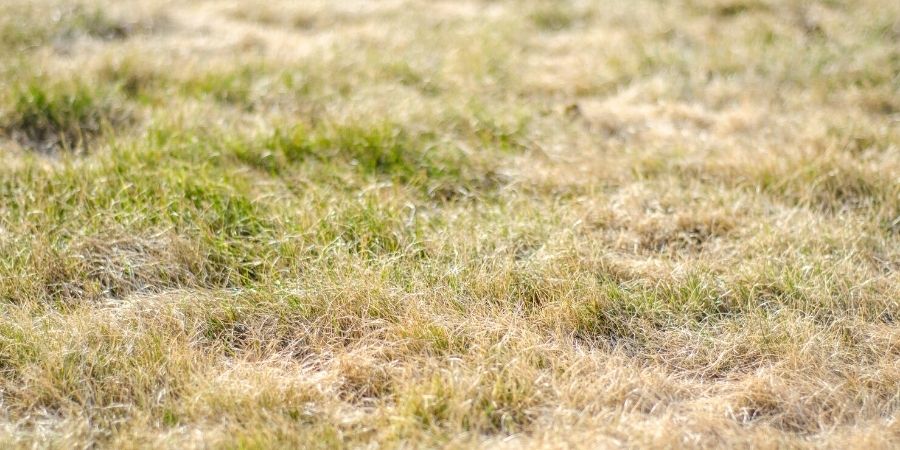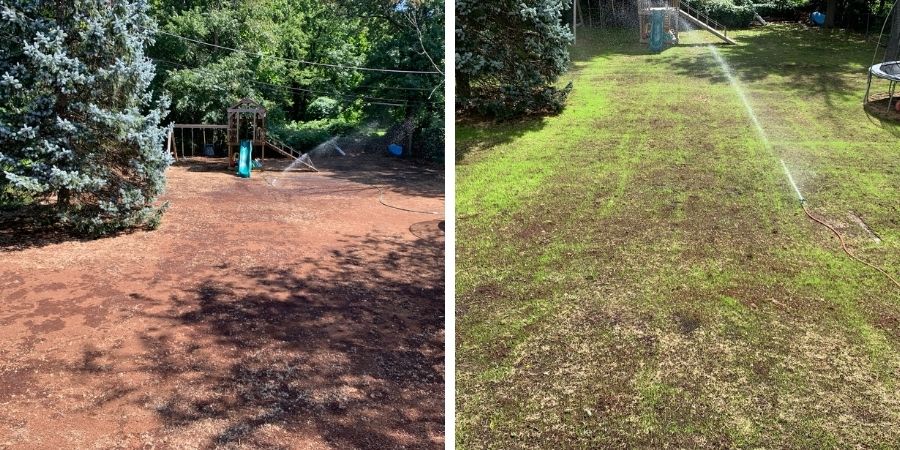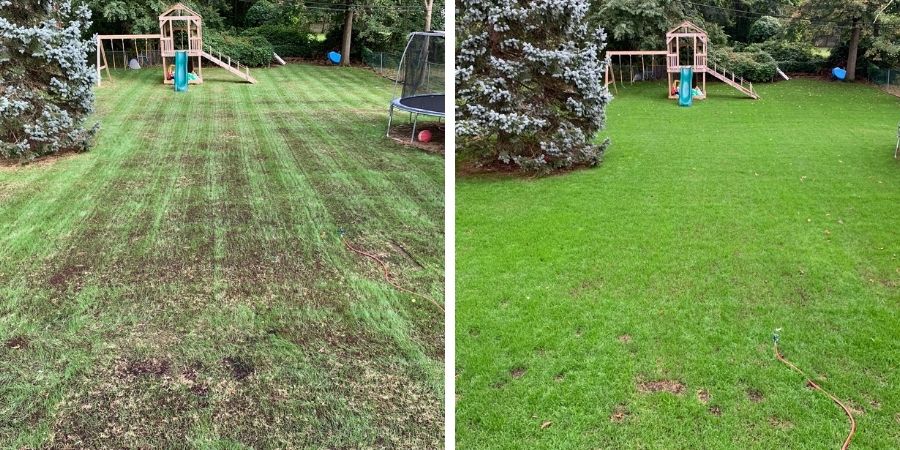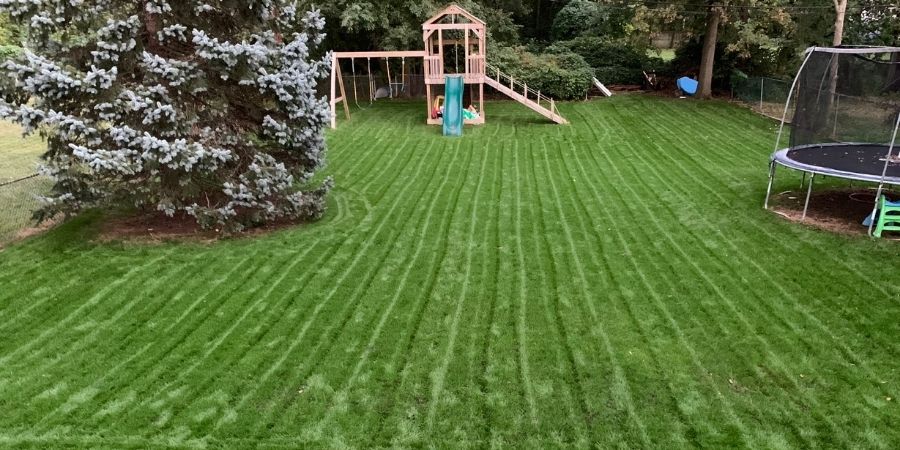How to Repair a Drought-Damaged Lawn in Fall by Overseeding, Patching or Re-seeding
- Milorganite AgronomistSeptember 7, 2023
It’s been a stressful growing season for many yards, gardens, and homeowners. The heat and drought conditions have taken their toll. This fall our lawns are crispy instead of lush and green.
Weather is the most limiting factor to the health of the turf, especially water. Maintaining a healthy lawn is a partnership between you and the weather and the weather hasn’t been a good partner this growing season. You can do everything you’re “supposed to” to maintain your lawn, but if the weather doesn’t cooperate, it’s just not going to thrive. It’s safe to apply Milorganite during a drought, but it’s not going to bring your lawn back to being healthy and green. That will happen when the weather cooperates.
Lawns go into drought-induced dormancy in extended hot, dry weather. Depending on how you did or didn’t care for your lawn throughout the drought, you may have bare patches, or large areas where your lawn has died. (I hope that’s not the case.) Either way, you're likely going to add to your usual fall lawn maintenance tasks to address drought damage.
Fall is the best time to repair dead or struggling patches in your lawn because weather conditions have returned that grass needs to grow. The best time to repair a lawn of cool-season grasses is when daytime air temperatures are in the low- to mid-70s and soil temperatures are in the mid-50s, which you can find here by entering your zip code. These are the perfect conditions for grass to grow.

Overseeding vs. Re-seeding Your Lawn
Talking with customers, I find there’s confusion on the difference between overseeding and re-seeding a lawn. They’re not the same, but the terms are often incorrectly used interchangeably.
Overseeding is applying grass seed to an existing lawn to thicken the turf or maintain a year-round color, depending on where you live. Overseeding is best for large areas of thin or sparse lawns, including those damaged by drought. Overseeding is not the solution if the lawn is bare. That will require re-seeding.
Re-seeding is striping your yard down to the soil and starting from scratch.
If drought conditions killed only portions of your lawn or diseases took advantage of the hot, dry weather, you may only need to repair the dead patches. If the drought damage to your lawn is extensive, you’ll have to replace your entire lawn.
If you’re starting from scratch, you may consider using sod, plugs, or sprigs to renovate your lawn. It depends on your budget, time, and expectations for how quickly you want your lawn to grow. No matter how you decide to renovate your lawn, fall is the best time for planting grass seed and sodding.
Below are steps to overseed, patch, and re-seed your lawn to repair drought-induced damage. Milorganite customer, Matt W. of Abington, Pennsylvania, also shares some of what he learned in the process of re-seeding his entire lawn.

Matt's backyard at the start of re-seeding his entire lawn
“This is the 5th year in our house in Abington PA a suburb of Philadelphia. My lawn was mostly creeping bentgrass and wide blade clumping fescue. We had lawn care service for about 4 years with little to no results. I started watching your content just before our COVID-19 stay-at-home time, which inspired me to cancel my lawn care service and get to know my turf. I made a lawn map of my yard square footage and started to purchase some tools I needed. I quickly came to the conclusion that I needed to start over to get rid of the fescue and bentgrass.” Matt W. of Abington, Pennsylvania
Choosing the Right Grass Seed
First, identify the grass varieties in your lawn. Are they thriving or barely surviving? This will help you choose the best grass seed varieties for overseeding or re-seeding your lawn.
Purchase cool-season or warm-season grass seed varieties that will thrive in your climate and growing conditions. Consider drought-resistant varieties to help avoid future drought damage.
If you have a variety of growing conditions in your yard—wet, dry, sunny, shady—choose newer turfgrass varieties that specifically address those conditions. It’s common to use native or a mix of grass varieties to overseed or re-seed your lawn. Contact your local university extension office for guidance on grass varieties that grow well in your area.
Look for grass seed that has a low percentage of weed seeds. You’ll also find the days to germination on the grass seed package label. This is important to know so you don’t give up and stop watering prematurely.

Matt's lawn starting to fill in. Matt researched types of grass before purchasing seeds. “Don’t just grab a bag of grass seed from the shelf and throw it down. The caliber of grass seed you buy makes a difference. There’s a reason why some grass seed is more expensive.” He used a mix of Fescue, Perennial Ryegrass, and Bluegrass. He noted that each grass variety germinated at a different rate.
When to Overseed Your Lawn
Overseeding is used to thicken thin or sparse lawns to improve health, disease, and pest resistance, and increase density, which helps reduce weeds. Seed is spread over the existing lawn. It’s an opportunity to introduce improved turfgrass varieties that will thrive in your climate and yard conditions, and are drought tolerant and disease resistant.
The reason and season to overseed differs if you are growing cool-season grasses or warm-season grasses.
Overseeding Cool-Season Grasses
Overseeding in fall with cool-season grasses in the North and parts of the transition zone is used to thicken up your lawn to improve its overall health.
Early fall is the best time to overseed cool-season grasses. The grass is actively growing and has time to mature before winter hits. Grass seed germinates best when night-time temperatures are in the 50s and soil temperatures are about the same. Planting grass seed in fall is optimum. The second best time to seed your lawn is in the spring.
Overseeding Warm-Season Grasses
There are two reasons to overseed in the South or warmer areas of the transition zone, where summers are hot and winters mild. The first is to provide seasonal color using cool-season grass varieties when warm-season grasses are dormant. The cool-season grass varieties will die off when summer heat and rain return. It’s not just going dormant.
For seasonal overseeding, choose a cool-season grass variety that’s quick-growing and needs cooler winter weather. You’ll know it’s time to overseed when the existing lawn starts to lose its color.
The second reason is the same as in the North. Overseeding is used to thicken lawns using grass varieties that are either the same as the existing lawn or by adding new grass varieties of turfgrass for a thicker, stronger lawn.
Overseed in summer using warm-season grass varieties that need heat to grow. You can reinforce the grass varieties in your lawn or add new varieties to improve its overall health. St. Augustinegrass is an exception. It’s nearly impossible to grow St. Augustinegrass from seed.
How to Overseed Your Lawn
- Cool-season grasses should overseed in fall when daytime temperatures are in the low- to mid-70s and soil temps are in the 50s. Warm-season grasses should overseed for winter color when your lawn begins to fade as it goes into its seasonal dormancy, which could be as early as late August and as late as October.
- Mow the lawn short and remove clippings to optimize seed-to-soil contact. Rake to remove remaining debris and loosen the soil.
- If there’s more than a half-inch of thatch, rent a dethatcher to remove it. It’s a barrier to seed-to-soil contact and can reduce seed germination. Use a core aerator to loosen compacted soil. Although aerating your lawn is helpful before overseeding, it’s not essential.
- Mix four parts Milorganite with one part grass seed by weight. It will help you see where you’ve applied particularly tiny grass seed and provides nutrients for the germinating seeds. You’re also saving time by seeding and fertilizing at the same time. Milorganite is low-nitrogen, which is good for fertilizing newly planted seeds. It’s also non-burning, so won’t damage tender grass blades. This replaces your early fall application of Milorganite.
- Spread half of the Milorganite/grass seed mix in one direction then apply the other half in the opposite direction to avoid inadvertent stripes.
- Water as needed to keep the top few inches of soil moist.
- Limit activities on the lawn.
- Resume mowing when the new grass reaches 3–4”. Remember: never remove more than one-third of the grass blade at a time. Leave clippings on the lawn.
- Don’t apply herbicides too soon before or after overseeding. Check herbicide labels for how long to wait which is typically 6–8 weeks. Make sure the herbicide is formulated for your varieties of grass.
Patching Bare Spots: A Mini Re-seeding
Bare patches in the lawn can be caused by hot, dry weather. These conditions are also conducive to several lawn diseases, such as rust, dollar spot; brown patch, and dog spot. Heavy traffic is another cause of bare patches.
Here are the steps for patching bare spots in the lawn. The steps for re-seeding the entire lawn are nearly the same.
- Rake to remove dead grass and weeds, and loosen the soil. If weeds are persistent, spot treat using a non-selective herbicide; it kills everything. Follow label directions.
- You can purchase a lawn repair kit that includes seed and mulch or you can make your own by mixing grass seed, soil or compost, and Milorganite.
- Sprinkle the seed or mix on the prepared soil and lightly rake it in for good seed-to-soil contact.
- Spread a layer of mulch, such as peat moss or hay, to keep the soil moist.
- Water as needed to keep the top few inches of soil moist.
- Resume mowing when the grass reaches 3–4”. You know a decent root system is forming at that height.
Re-seeding Your Lawn Step-by-Step
Re-seeding your lawn is like patching, but on a much larger scale and requires more preparation. The steps for re-seeding your lawn are the same whether you live in the North or South; it’s the season and grass varieties that differ. Here are the steps to re-seeding your lawn.

Matt's completed backyard after re-seeding.
Matt was surprised by the amount of prep work needed. “I didn’t realize how long it would take to get the lawn down to nothing and the steps to prepare the soil before being able to spread seed.” Re-seeding a lawn isn’t a weekend task.
- Kill off any remaining grass and weeds, preferably using non-chemical means such as covering the area with plastic or several layers of newspaper to kill all vegetation. Spot treat stubborn weeds with a non-selective herbicide following label directions as to how soon after application you can seed. After his lawn was dead, Matt used an electric dethatcher to remove what was left. “Then I used my mower with the bag attachment to collect everything.” He took the extra step and aerated as well.
- If the soil is highly compacted, rent a core aerator to loosen the soil, which is what I would do. Fall is the best time to aerate. Apply Milorganite after aerating. Alternatively, if your budget allows, you can till 2” of compost, peat moss, or other organic matter into the top 6–8” of soil.
- Add topsoil to level uneven areas. Matt used a 50/50 blend of topsoil and compost. If you tilled, this is a good time to apply Milorganite. This is also a good time to amend the soil based on a soil analysis.
- Purchase a grass seed mix that will thrive in your area.
- Distribute grass seed using a spreader. Spread half in one direction and the other half in the opposite direction. If you didn’t add Milorganite when preparing the soil, you can apply it now by mixing the grass seed with Milorganite and throw-down both at the same time. Gently rake to ensure good seed-to-soil contact using a metal rake. Matt used a starter fertilizer after seeding his lawn. “I applied Milorganite when the grass was up and did another application at the end of fall—about 6–8 weeks after the grass came up. I was scared to use any other kind of fertilizer. I used Milorganite because it wouldn’t kill the lawn and would also help amend the soil. You can’t kill the lawn with Milorganite.”
- Cover with organic material, such as peat moss, hay, or hay mats that are rolled out. Matt chose peat moss. He found that it kept the grass seed moist and helped keep the birds from eating all of the seed. “It was also a visible indicator. It turns a lighter color when it’s dry. From the back door, I could see right away where the lawn needed to be watered.”
- Keep the soil moist until the seeds sprout. If you’re not getting much rain, it’s critical that you water to supplement the rain.

